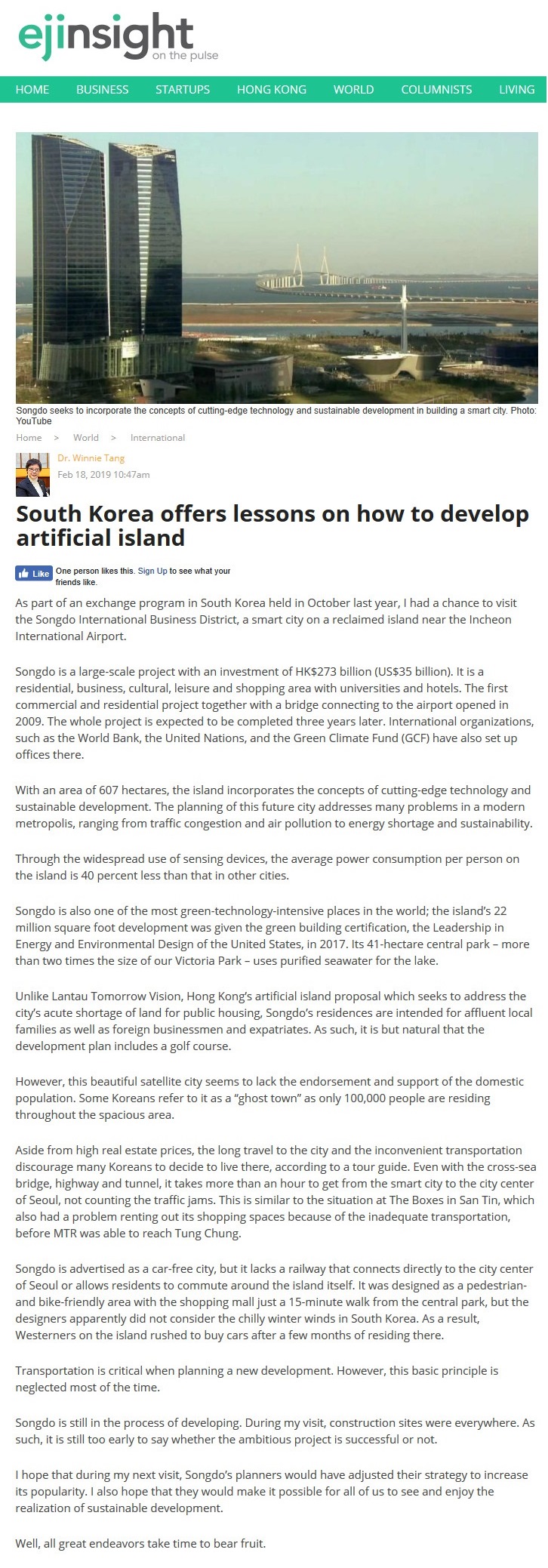網上版請按此

South Korea offers lessons on how to develop artificial island
As part of an exchange program in South Korea held in October last year, I had a chance to visit the Songdo International Business District, a smart city on a reclaimed island near the Incheon International Airport.
Songdo is a large-scale project with an investment of HK$273 billion (US$35 billion). It is a residential, business, cultural, leisure and shopping area with universities and hotels. The first commercial and residential project together with a bridge connecting to the airport opened in 2009. The whole project is expected to be completed three years later. International organizations, such as the World Bank, the United Nations, and the Green Climate Fund (GCF) have also set up offices there.
With an area of 607 hectares, the island incorporates the concepts of cutting-edge technology and sustainable development. The planning of this future city addresses many problems in a modern metropolis, ranging from traffic congestion and air pollution to energy shortage and sustainability.
Through the widespread use of sensing devices, the average power consumption per person on the island is 40 percent less than that in other cities.
Songdo is also one of the most green-technology-intensive places in the world; the island's 22 million square foot development was given the green building certification, the Leadership in Energy and Environmental Design of the United States, in 2017. Its 41-hectare central park – more than two times the size of our Victoria Park – uses purified seawater for the lake.
Unlike Lantau Tomorrow Vision, Hong Kong's artificial island proposal which seeks to address the city's acute shortage of land for public housing, Songdo's residences are intended for affluent local families as well as foreign businessmen and expatriates. As such, it is but natural that the development plan includes a golf course.
However, this beautiful satellite city seems to lack the endorsement and support of the domestic population. Some Koreans refer to it as a "ghost town" as only 100,000 people are residing throughout the spacious area.
Aside from high real estate prices, the long travel to the city and the inconvenient transportation discourage many Koreans to decide to live there, according to a tour guide. Even with the cross-sea bridge, highway and tunnel, it takes more than an hour to get from the smart city to the city center of Seoul, not counting the traffic jams. This is similar to the situation at The Boxes in San Tin, which also had a problem renting out its shopping spaces because of the inadequate transportation, before MTR was able to reach Tung Chung.
Songdo is advertised as a car-free city, but it lacks a railway that connects directly to the city center of Seoul or allows residents to commute around the island itself. It was designed as a pedestrian- and bike-friendly area with the shopping mall just a 15-minute walk from the central park, but the designers apparently did not consider the chilly winter winds in South Korea. As a result, Westerners on the island rushed to buy cars after a few months of residing there.
Transportation is critical when planning a new development. However, this basic principle is neglected most of the time.
Songdo is still in the process of developing. During my visit, construction sites were everywhere. As such, it is still too early to say whether the ambitious project is successful or not.
I hope that during my next visit, Songdo's planners would have adjusted their strategy to increase its popularity. I also hope that they would make it possible for all of us to see and enjoy the realization of sustainable development.
Well, all great endeavors take time to bear fruit.
Dr. Winnie Tang
Adjunct Professor, Department of Computer Science, Faculty of Engineering and Faculty of Architecture, The University of Hong Kong